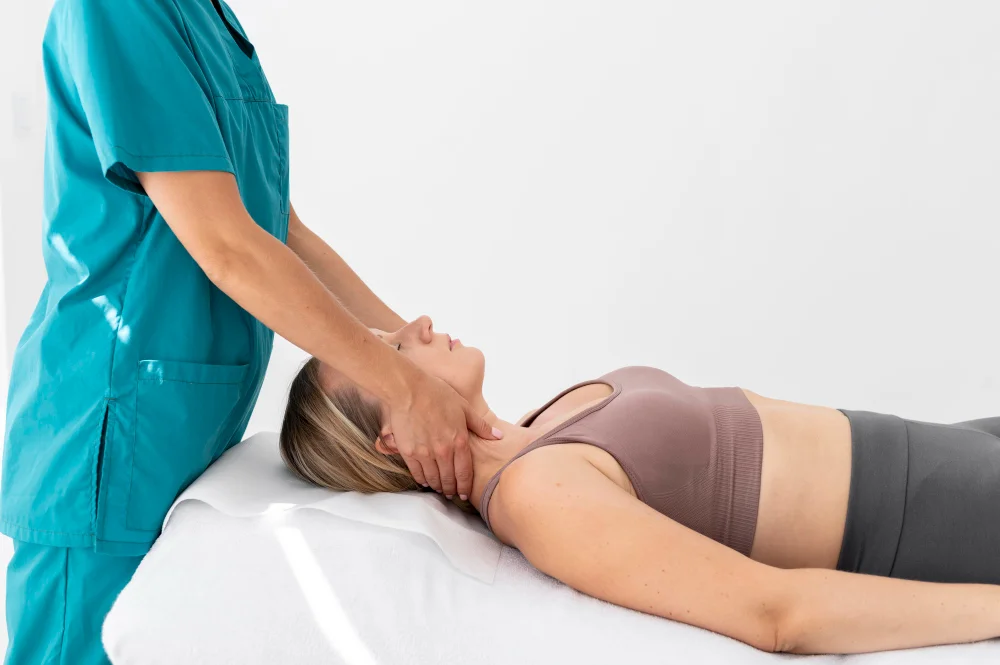Ever sat beside a loved one, hearing them struggle to breathe — and felt helpless?
That’s how I felt one evening while visiting a long-time patient recovering from pneumonia. He was producing so much mucus that even a simple conversation left him breathless. His family had tried everything: humidifiers, medicines, even steam inhalation. But it wasn’t until we introduced structured chest physiotherapy that things began to improve — slowly, but surely.
If you’re caring for an adult with a chronic lung condition or a recent respiratory infection, knowing how to perform chest physiotherapy (CPT) can make all the difference — not just for comfort, but for survival.
At Cure on Call, we’ve helped countless families learn this essential skill. In this article, we’re sharing not only the clinical science behind CPT but also how we apply it during home physiotherapy sessions with real patients in Faisalabad and beyond.
What Is Chest Physiotherapy — and Why Is It Important?
Chest physiotherapy is a hands-on set of techniques used to help clear mucus (sputum) from the lungs. It’s especially helpful for adults with conditions like:
- Chronic obstructive pulmonary disease (COPD)
- Pneumonia
- Bronchiectasis
- Cystic fibrosis (though more common in children)
- Post-surgical respiratory complications
By loosening and moving mucus toward the upper airways, CPT can make it easier to cough it out, improving lung function and oxygen intake.
According to the American Thoracic Society, effective airway clearance reduces infection risk, decreases hospital stays, and improves quality of life.
Tools You Might Need
While manual chest therapy is effective on its own, having a few tools on hand can make things easier:
- Pillow or rolled towel for positioning
- Tissues or a sputum bowl
- Hand sanitiser or gloves (especially in infections)
- Incentive spirometer (optional for breathing exercises)
Some patients also benefit from oscillating positive expiratory pressure (PEP) devices, but we’ll focus here on manual therapy techniques that anyone can learn and perform at home.
Step-by-Step: How to Do Chest Physiotherapy for Adults
Let’s break it down into stages — positioning, percussion, vibration, and coughing.
1. Positioning for Drainage (Postural Drainage)
Positioning is key because gravity helps move mucus from deeper parts of the lungs toward the central airways.
How we do it at Cure on Call:
We assess which lobe of the lung is affected (based on X-rays or symptoms) and use the appropriate posture. For example:
- To drain the lower lobes, we lie the patient on their stomach with a pillow under the hips.
- For upper lobes, we seat them upright or lean slightly back.
Tip: Keep each position for about 5–10 minutes. If dizziness or breathlessness occurs, stop and reassess.
2. Percussion (Clapping)
Percussion involves rhythmically clapping on the chest wall using cupped hands to loosen mucus.
Technique:
- Use a cupped hand (fingers and thumb together)
- Clap over a towel to reduce discomfort
- Avoid areas over the spine, sternum, or lower ribs
- Clap for 2–3 minutes per area
Real tip from our experience: Many first-time carers feel unsure if they’re ‘doing it right’. Don’t worry — it should sound hollow, not slappy. If it’s painful, adjust your hand shape or try using a towel.
3. Vibration
After percussion, apply gentle vibrations during the patient’s exhalation to help move loosened mucus.
Technique:
- Place both hands flat on the patient’s chest
- Apply gentle, rapid pressure in a shaking motion while they exhale
- Repeat for 3–5 breaths
4. Directed Coughing
Once mucus is mobilised, it needs to come out. A proper cough — not just a throat-clearing — is essential.
Steps:
- Ask the patient to inhale deeply, hold for 2 seconds
- Then cough forcefully while exhaling
- Use tissues or a sputum cup to collect mucus
If coughing is difficult, try “huff coughing” — a forced exhale with an open mouth (like fogging a mirror).
How Often Should You Do Chest Physiotherapy?
The frequency depends on the patient’s condition:
- Post-operative patients: 2–3 times daily
- Chronic lung disease: 2–4 times daily, depending on mucus production
- Acute infections: As recommended by your physiotherapist or doctor
Our team at Cure on Call usually starts with 2 sessions per day, increasing or reducing based on how the patient responds.
Safety Tips You Shouldn’t Skip
- Avoid CPT right after meals to reduce nausea
- Always wash hands before and after treatment
- Stop if the patient feels dizzy, vomits, or has chest pain
- Keep emergency numbers accessible in case of breathing distress
“Chest physiotherapy is safe and effective when done properly — but it’s not a one-size-fits-all approach. Each patient’s needs are different,” says Dr. Sana Iqbal, lead physiotherapist at Cure on Call.
Alternatives and Adjuncts to Manual CPT
We’ve found that some adults struggle with manual therapy due to pain or mobility issues. In such cases, we often incorporate:
- Positive Expiratory Pressure (PEP) devices
- Inhaled bronchodilators or mucolytics (prescribed)
- Breathing exercises like pursed-lip breathing or diaphragmatic breathing
We also encourage light walking, which naturally increases airflow and helps mucus movement.
Frequently Asked Questions (FAQ)
What are the risks of chest physiotherapy?
When done correctly, CPT is safe. Rare side effects may include light-headedness, fatigue, or minor bruising. Avoid in patients with rib fractures, recent chest surgeries, or bleeding disorders.
Can I perform chest physiotherapy at home?
Yes. With proper guidance, CPT can be safely performed by trained family members. At Cure on Call, we provide home training sessions to ensure accuracy and safety.
Do adults benefit as much as children from CPT?
Absolutely. While CPT is often associated with paediatrics, many adult patients — especially post-op or those with chronic bronchitis — see significant relief.
How do I know if it’s working?
Reduced coughing episodes, easier breathing, and improved oxygen levels are good indicators. We sometimes measure peak flow before and after sessions for quantifiable results.
Final Thoughts: Don’t Let Mucus Muffle Your Life
Chest physiotherapy isn’t just a technique — it’s a lifeline for adults battling chronic or acute respiratory issues. With care, consistency, and a bit of courage, you can help a loved one breathe easier — right from the comfort of home.
And if you’re unsure where to begin, we’re here to guide you.
Have questions or need a home consultation in Faisalabad?
Drop us a message — Cure on Call’s experienced physiotherapists are ready to help.
Read Also: Is Red Light Therapy Bad for Your Eyes?
Author Bio: Cure on Call is a Faisalabad-based team of certified physiotherapists offering home-based care for respiratory therapy, orthopaedic rehab, neurophysiotherapy, and more.
Sources:
- American Thoracic Society — www.thoracic.org
- National Health Service (UK) — www.nhs.uk
- Mayo Clinic — www.mayoclinic.org




